Host: Fraser Cain (@fcain)
Guests:
Morgan Rehnberg (cosmicchatter.org / @cosmic_chatter)
Continue reading “Weekly Space Hangout – Oct. 17, 2014: Comet Siding Spring & Dark Matter”
Host: Fraser Cain (@fcain)
Guests:
Morgan Rehnberg (cosmicchatter.org / @cosmic_chatter)
Continue reading “Weekly Space Hangout – Oct. 17, 2014: Comet Siding Spring & Dark Matter”
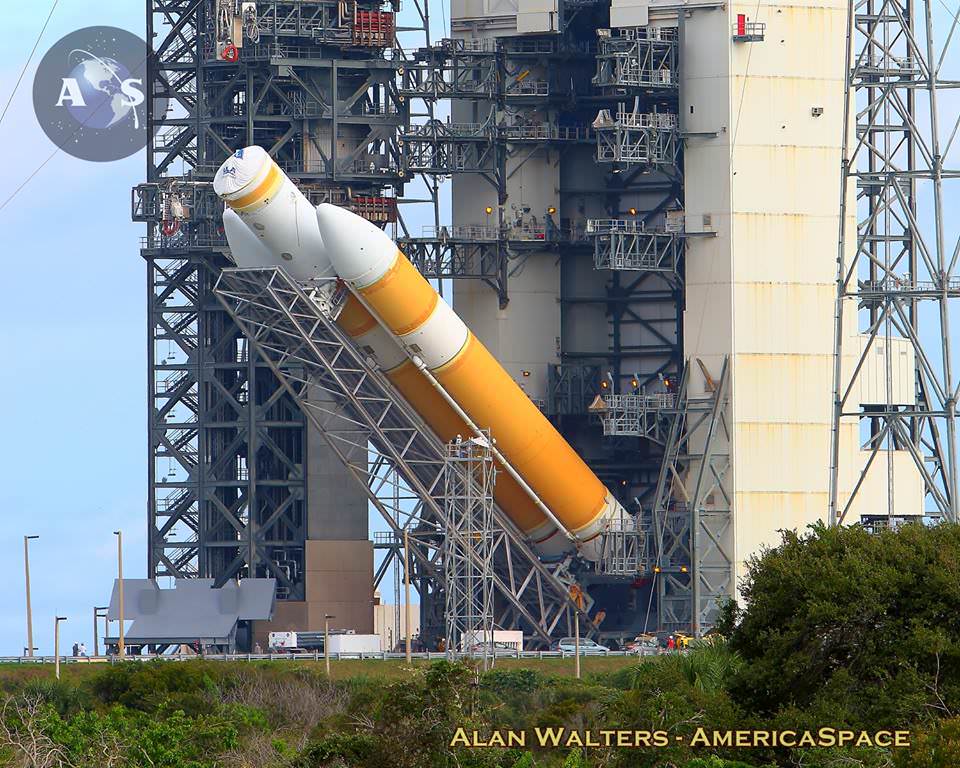
The march towards first launch of NASA’s next generation Orion crew vehicle is accelerating rapidly.
The world’s most powerful rocket – the United Launch Alliance Delta IV Heavy – was moved to its Cape Canaveral launch pad overnight and raised at the pad today, Oct. 1, thereby setting in motion the final steps to prepare for blastoff of NASA’s new Orion capsule on its first test flight in just over two months.
All the pieces are ready and now it’s just a matter of attaching all those components together for the inaugural uncrewed liftoff of the state-of-the-art Orion spacecraft on its maiden mission dubbed Exploration Flight Test-1 (EFT-1) in December.
“We’ve been working toward this launch for months, and we’re in the final stretch,” said Kennedy Director Bob Cabana, in a NASA statement.
“Orion is almost complete and the rocket that will send it into space is on the launch pad. We’re 64 days away from taking the next step in deep space exploration.”
The triple barreled Delta IV Heavy topped by the Orion EFT-1 capsule is slated to blastoff on December 4, 2014, from Space Launch Complex 37 (SLC-37) at Cape Canaveral Air Force Station in Florida.
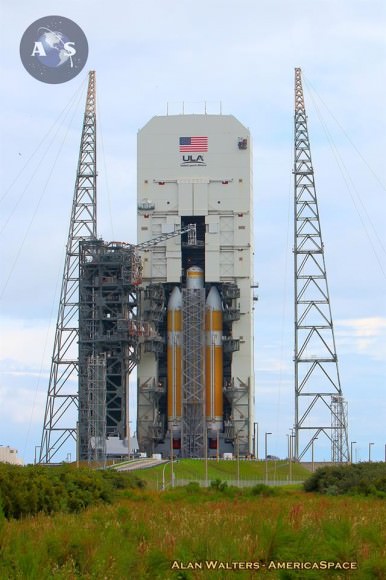
After a nearly two day delay due to drenching rain storms, the Delta IV Heavy integrated first and second stages were transported horizontally overnight Wednesday starting around 10 p.m. from the processing hanger inside ULA’s Horizontal Integration Facility (HIF) to the nearby launch complex and servicing gantry at Pad 37.
Early this morning, the rocket was hoisted up into its launch configuration. Several of my space photo-journalist colleagues were on hand. See their photos herein.
From now until launch technicians will conduct the final processing, testing and checkout of the Delta IV Heavy booster. They will also carry out “a high fidelity rehearsal to include fully powering up the booster and loading the tanks with fuel and oxidizer,” according to ULA.
“This is a tremendous milestone and gets us one step closer to our launch later this year,” said Tony Taliancich, ULA’s director of East Coast Launch Operations, in a ULA statement.
“The team has worked extremely hard to ensure this vehicle is processed with the utmost attention to detail and focus on mission success.”
“The Delta IV Heavy is the world’s most powerful launch vehicle flying today, and we are excited to be supporting our customer for this critical flight test to collect data and reduce overall mission risks and costs for the program,” said Taliancich.
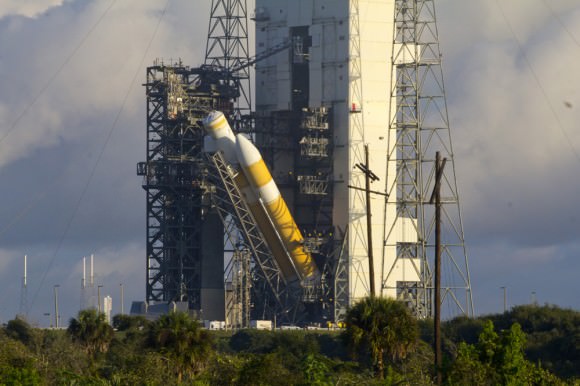
NASA’s Orion Program manager Mark Geyer told me in a recent interview that the Orion spacecraft, built by prime contractor Lockheed Martin, will be transported to the pad around November 10 or 11. Then the Orion will be hoisted and attached to the top of the Delta IV Heavy rocket at the base of its service module.
The Delta IV Heavy first stage is comprised of a trio of three Common Booster Cores (CBCs).
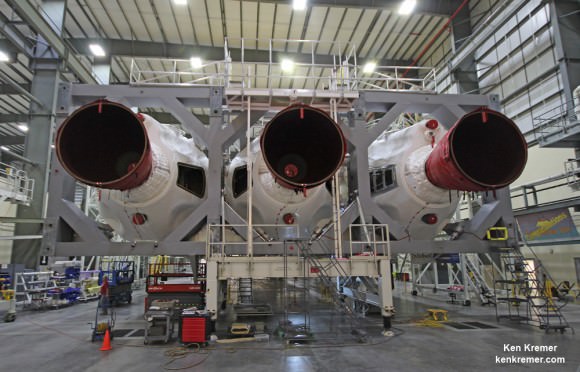
Each CBC measures 134 feet in length and 17 feet in diameter. They are equipped with an RS-68 engine powered by liquid hydrogen and liquid oxygen propellants producing 656,000 pounds of thrust. Together they generate 1.96 million pounds of thrust.
The Delta IV Heavy became the world’s most powerful rocket upon the retirement of NASA’s Space Shuttle program and is the only vehicle that is sufficiently powerful to launch the Orion EFT-1 spacecraft.
The first CBC booster was attached to the center booster in June. The second one was attached in early August.
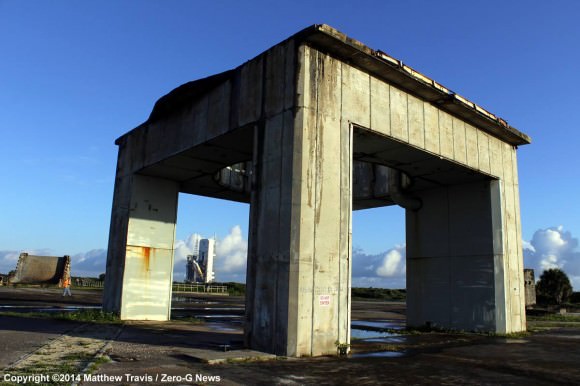
I recently visited the HIF during a media tour after the three CBCs had been joined together as well as earlier this year after the first two CBCs arrived by barge from their ULA assembly plant in Decatur, Alabama, located about 20 miles west of Huntsville. See my photos herein.
I was also on hand at KSC when the Orion crew module/service module (CM/SM) stack was rolled out on Sept. 11, 2014, on a 36 wheeled transporter from its high bay assembly facility in the Neil Armstrong Operations and Checkout Building.
It was moved about 1 mile to the KSC fueling facility named the Payload Hazardous Servicing Facility (PHFS). Read my Orion move story – here.
Fueling of Orion was completed over the weekend and it has now been moved to the Launch Abort System Facility (LASF) for the installation of its last component – the Launch Abort System (LAS).
Orion’s next stop is SLC-37.
The two-orbit, four and a half hour EFT-1 flight will lift the Orion spacecraft and its attached second stage to an orbital altitude of 3,600 miles, about 15 times higher than the International Space Station (ISS) – and farther than any human spacecraft has journeyed in 40 years.
NASA is simultaneously developing a monster heavy lift rocket known as the Space Launch System or SLS, that will eventually launch Orion on its deep space missions.
The maiden SLS/Orion launch on the Exploration Mission-1 (EM-1) unmanned test flight is now scheduled for no later than November 2018 – read my story here.
SLS will be the world’s most powerful rocket ever built and the assembly of its core stage has begun at NASA’s Michoud Assembly Facility in New Orleans. Read my story – here.
Stay tuned here for Ken’s continuing Orion, SLS, Boeing, Sierra Nevada, Orbital Sciences, SpaceX, commercial space, Curiosity, Mars rover, MAVEN, MOM and more Earth and planetary science and human spaceflight news.
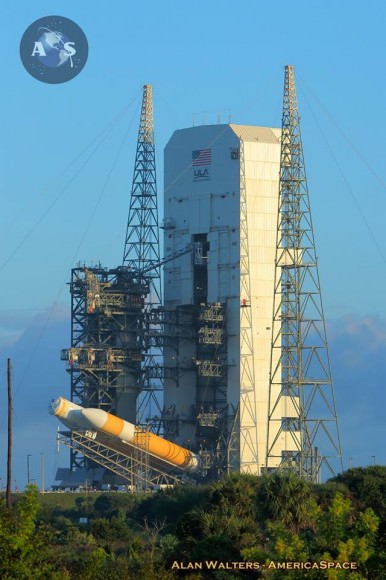
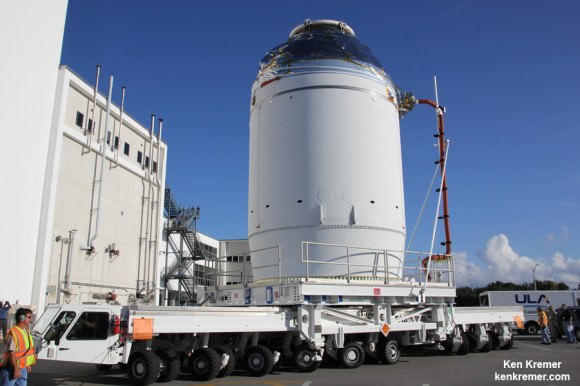
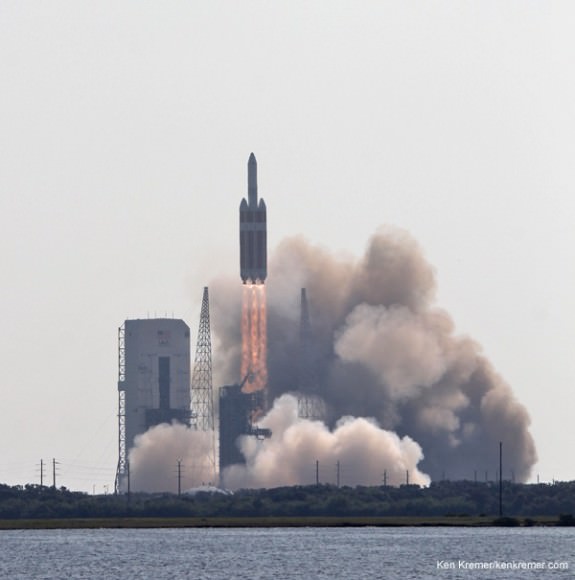
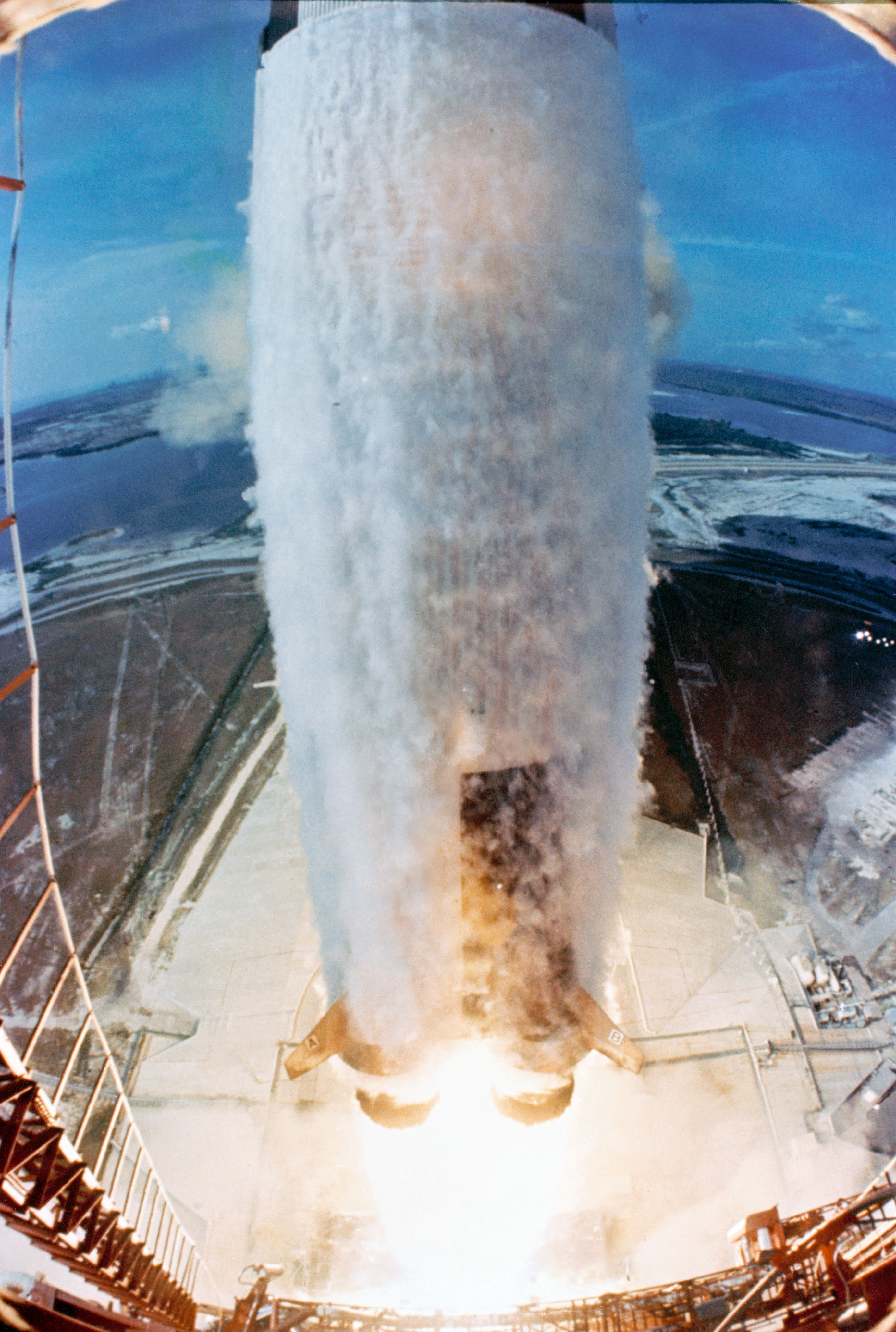
45 years ago today — on July 16th, 1969 — the Apollo 11 crew left Earth for the first human mission to land on the Moon. Launching on at Saturn V rocket from Cape Kennedy, the mission sent Commander Neil Armstrong, Command Module Pilot Michael Collins and Lunar Module Pilot Edwin “Buzz” Aldrin into an initial Earth-orbit, and then two hours and 44 minutes after launch, another burn of the engines put Apollo 11 into a translunar orbit.
If you want to re-live the launch and the mission, there are several ways you can participate. We’ve included here a few different replays of the launch, varying from a quick recap to a detailed look at the launch itself. Above is the newscast of the launch from CBS news with Walter Cronkite, and we’ve got more below.
Also below is information on several webcasts and other events that NASA has planned to commemorate the anniversary.
Here’s a detailed look at the launch in ultra-slow motion, with narration:
Here is some remastered high definition footage from NASA of the Apollo 11 launch, but there’s no audio.
And here’s a quick look at the entire Apollo 11 mission, all in just 100 seconds from Spacecraft Films:
Here are some ways to participate in the anniversary:
On Twitter, @ReliveApollo11 from the Smithsonian National Air and Space Museum is reliving the highlights from Apollo 11 mission to the Moon in “real time” 45 years later.
Also @NASAHistory is tweeting images and events from the mission, and journalist Amy Shira Teitel (@astVintageSpace ) is tweeting out some interesting pictures, facts and quotes from the mission, in “real time” (again 45 years later).
To join the ongoing conversation on social media about the anniversary and NASA’s deep space exploration plans, use the hashtags #NextGiantLeap and #Apollo45.
On Friday, July 18 at 10:30 a.m. PDT (1:30 p.m. EDT), NASA TV will air a live conversation about the future of space exploration with actor, director and narrator Morgan Freeman. He will speak at NASA’s Jet Propulsion Laboratory in Pasadena, California, about his personal vision for space. The event also will include NASA astronaut Reid Wiseman participating from the International Space Station.
If you don’t have NASA TV on your cable or satellite feeds, you can watch online here.
Also on Friday at 3:30 p.m. EDT, NASA will host a discussion with Buzz Aldrin and astronaut Mike Massimino at the Intrepid Sea, Air & Space Museum in New York during the Intrepid Space and Science Festival. NASA also will have exhibits and activities at the festival Thursday, July 17 through Saturday, July 19. There’s more information about the festival here.
On Sunday, July 20 at 7:39 p.m. PDT (10:39 p.m. EDT), when Armstrong opened the spacecraft hatch to begin the first spacewalk on the moon, NASA TV will replay the restored footage of Armstrong and Aldrin’s historic steps on the lunar surface.
On Monday, July 21 at 7 a.m. PDT (10 a.m. EDT) from the agency’s Kennedy Space Center in Florida, NASA TV will air live coverage of the renaming of the center’s Operations and Checkout Building in honor of Armstrong, who passed away in 2012. The renaming ceremony will include NASA Administrator Charles Bolden, Kennedy Center Director Robert Cabana, Apollo 11’s Collins, Aldrin and astronaut Jim Lovell, who was the mission’s back-up commander. International Space Station NASA astronauts Wiseman and Steve Swanson, who is the current station commander, also will take part in the ceremony from their orbiting laboratory 260 miles above Earth.
Kennedy’s Operations and Checkout Building has played a vital role in NASA’s spaceflight history. It was used during the Apollo program to process and test the command, service and lunar modules. Today, the facility is being used to process and assemble NASA’s Orion spacecraft, which the agency will use to send astronauts to an asteroid in the 2020s and Mars in the 2030s.
On Thursday, July 24 at 3 p.m. PDT (6 p.m. EDT), which is the 45th anniversary of Apollo 11’s return to Earth, the agency will host a panel discussion — called NASA’s Next Giant Leap — from Comic-Con International in San Diego. Moderated by actor Seth Green, the panel includes Aldrin, NASA Planetary Science Division Director Jim Green, JPL systems engineer Bobak Ferdowsi, and NASA astronaut Mike Fincke, who will talk about Orion and the Space Launch System rocket, which will carry humans on America’s next great adventure in space.
The NASA.gov website will host features, videos, and historic images and audio clips that highlight the Apollo 11 anniversary, as well as the future of human spaceflight. Find it all here.
Also, the Slooh telescope team will celebrate the 45th anniversary of the Apollo 11 landing with a high-definition broadcast of the lunar surface on Sunday, July 20th starting at 5:30 PM PDT / 8:30 PM EDT / 00:30 UTC (7/21) – (check International Times here) Slooh will broadcast the event live from a special feed located in Dubai in the United Arab Emirates.
Viewers can watch the event unfold free on Slooh.com, or in the webcast below. The image stream will be accompanied by discussions led by Slooh host, Geoff Fox, Slooh astronomer, Bob Berman, Slooh Observatory Engineer, Paul Cox, along with numerous special guests, including documentary filmmaker, Duncan Copp, and science journalist, Andrew Chaikin. Viewers can follow updates on the show by using the hashtag #SloohApollo11.

If you are 45 years or older, chances are you know where you were and what you were doing on July 20th, 1969 when Apollo 11 landed on the Moon. Apollo 11 lunar module pilot Buzz Aldrin says that when he travels around the world, people always want to tell him their stories from that day when he and Neil Armstrong walked on the Moon. And he says he actually likes to hear all these stories because he and his crewmates missed all the hubbub back on Earth, since they were decidedly off making history.
And now you can tell Buzz your story own story about Apollo 11, and share it with the world, as well. To celebrate the upcoming 45th anniversary of the Apollo 11 Moon landing, Buzz has just launched a social media campaign where you can share your story, your parents’, your grandparents’, or your friends’ stories of that moment and how it inspired you.
“I feel we need to remind people about our Apollo missions and that we can still do impossible things,” Buzz says in this new video, above.
You can tell your story on social media, using the hashtag #Apollo45, or visit the Apollo45 You Tube Channel where you can post a video of your recollections. Videos will be shared from the public as well as featured videos from astronauts, public figures and celebrities.
This can be a family and/or generational project. As Buzz says, “Kids, help your parents if they don’t know how to use their smartphones. Get them to tell you their memories.”
We’d also like to see your stories here on Universe Today. Post in the comment section below and if you create a video, post the link.
I’ll start with my story:
I was quite young, but I do remember sitting on the floor with my sister in front of the television set, basically glued there since we didn’t want to miss a thing. We felt really lucky because our parents let us stay up late to watch the first moonwalk. Later, my Mom got me a T-shirt that had an eagle (bird) landing on the Moon with an Apollo 11 mission patch and the date “July 20, 1969” emblazoned on it, and I basically wore it non-stop.
Hat tip to Leonard David for letting us know about #Apollo45!

On December 14, 1972, at about 5:40 a.m. GMT, Apollo 17 astronaut Eugene Andrew “Gene” Cernan returned to the lunar module Challenger after the end of the third mission EVA to join Harrison “Jack” Schmitt, completing nearly two and a half days of surface operations within the Taurus-Littrow site and officially becoming the last human to set foot upon the lunar surface. No one has returned since, and to this day the 80-year-old Cernan still holds the title of “last man on the Moon.”
If that’s not the perfect setup for a documentary film, I don’t know what is. Luckily for us there’s one in the works.
“The Last Man on the Moon,” from UK-based Mark Stewart Productions, tells the story of Gene Cernan and his accomplishments against the backdrop of the Apollo era, when superpowers competed for dominance in space and hotshot flyboys became international heroes. With firsthand accounts from Cernan himself and his family, along with several other astronauts and NASA celebrities, it’s an emotional and intimate account of America’s last lunar voyage.
Watch the trailer below:
According to IMDB the 99-minute documentary directed by Mark Craig is slated for release in the UK (and hopefully U.S.!) sometime this year, although an exact date isn’t listed. There have been advance screenings very recently, at some of which Cernan was present for Q&A sessions. Some viewers are calling it “the best space documentary they have seen” so needless to say I’m pretty excited about it!
You can keep up with the status of the film (and see some exclusive astronaut photos) by liking the Facebook page here and joining the mailing list on the official site.
And yes, we do need more films like this.
“I really wanted to reach out, stick it in my spacesuit and bring it home and show it to everybody: this is what it feels like.”
– Gene Cernan
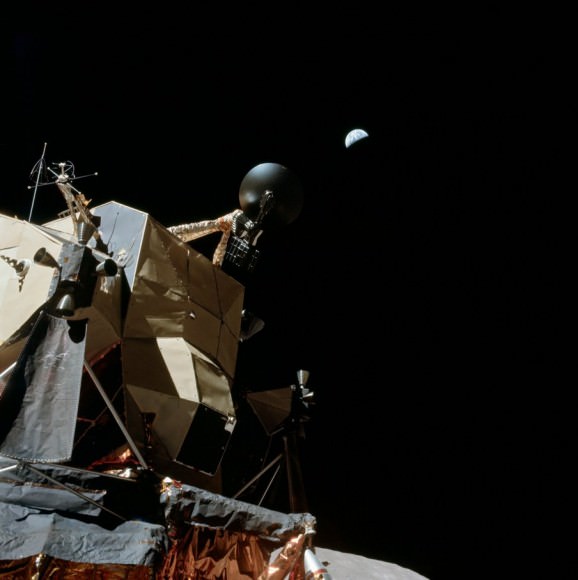
Video © Mark Stewart Productions. All rights reserved.
Almost every historic American launch occurred at one place in Cape Canaveral: Launch Complex 39. Good old LC39 was build for the Apollo spacecraft, and then modified for the Space Shuttle program. And now it’s carrying on this tradition for upcoming SpaceX rockets. Let’s explore the history of this instrumental launch facility.
Continue reading “Astronomy Cast Ep. 345: Numbered Places: Launch Complex 39”
If you’re reading this then you’re probably a big fan of space exploration. And while on one hand you could say that we are now living in a “golden age” of exploration, what with the ongoing missions there are around the Solar System and the new discoveries being made on an almost weekly basis about our Universe, on the other hand it seems like we are getting more and more “grounded” as human explorers, with still years to go before the first footprints are made on Mars, an ever-growing span since we last walked on the Moon, and steadily-shrinking or stagnant budgets that can’t support all the missions that DO exist — and sometimes cancel them altogether.
“We have discovered amazing places. But imagine what’s hiding where we haven’t even looked?”
In order for missions to ever get off the ground, they need to be funded. Right now NASA — still arguably the leader in space exploration among world agencies — receives a little over 0.4 percent of every U.S. tax dollar. Less than half a penny. That’s what NASA explores the Solar System with, what makes our knowledge of the Universe — from the farthest visible reaches right down to our own planet Earth — even possible. What if NASA were to receive a full one percent? A whole penny from every dollar? That’d still be only a quarter of what NASA worked with to put men on the Moon in 1969, but it’d be more than double what it gets now.
A penny for NASA… this is the goal of Penny4NASA.org, an outreach group that strives to increase the funding — if just by a little — of the world’s most accomplished, inspirational, and powerful space exploration administration. (Before… you know, it isn’t.)
The video above was created for Penny4NASA by artist and animator Brad Goodspeed, and reminds us of what NASA has achieved in its 50-year history, of what its goals are (or at least should be) and, unfortunately, why many of them have remained unattained. NASA needs support — our support — or else its candles will stay unlit and our windows and doors to the Universe will slowly but surely close.
How can you help? Well for one thing, stay excited about space and science (and get others excited too!) Interest is the key to making sure people don’t lose sight of what’s happening in the field; you might be surprised to hear the misinformation that’s been passed around. (No, NASA isn’t “dead.”) And let your policy-makers know that space exploration and the investment in technology and innovation that goes along with it is important to you — the Planetary Society has a convenient page where you can find links to write to your state representative here. And finally you can support groups like Penny4NASA, made up of enthusiastic young professionals who want to see our nation’s past successes in space exploration continued into their future.
“America is fading right now. Nobody’s dreaming about tomorrow anymore. NASA knows how to dream about tomorrow — if the funding can accommodate it, if the funding can empower it.”
– Neil deGrasse Tyson
Want more inspiration? Read this excerpt from Neil deGrasse Tyson’s Space Chronicles on TheWeek.com here.
Video credit: Brad Goodspeed/Penny4NASA.org

Sunrise over the surface of the moon: a series of star tracker images taken by LADEE Saturday, April 12. The lunar horizon is ahead, a few minutes before orbital sunrise. Image Credit: NASA Ames.
[/caption]
NASA’s Lunar Atmosphere and Dust Environment Explorer (LADEE) literally ‘saw the light’ just days before crashing into the lunar farside last Thursday April 17. Skimming just a few kilometers above the moon’s surface, mission controllers took advantage of this unique low angle to gaze out over the moon’s horizon in complete darkness much like the Apollo astronauts did from lunar orbit more than 40 years ago.
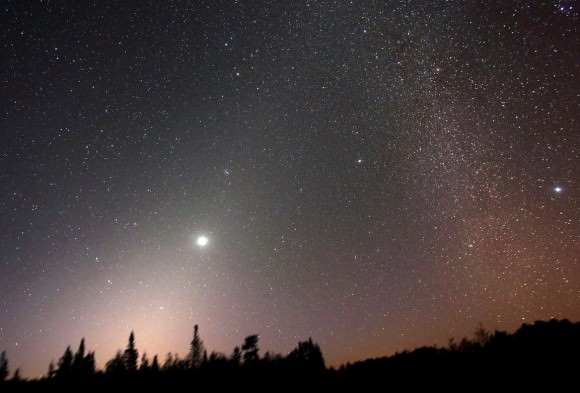
With the glow of Earth well-hidden, any dust in the moon’s scant atmosphere around the time of orbital sunrise should become visible. Scientists also expected to see the softly luminous glow of the zodiacal light, an extensive cloud of comet and asteroid dust concentrated in the flat plane of the solar system. The zodiacal light gets its name from the zodiac, that familiar band of constellations the planets pass through as they orbit the sun. Back on Earth, the zodiacal light looks like a big thumb of light standing up from the western horizon a couple hours after sunset in spring and before sunrise in fall.
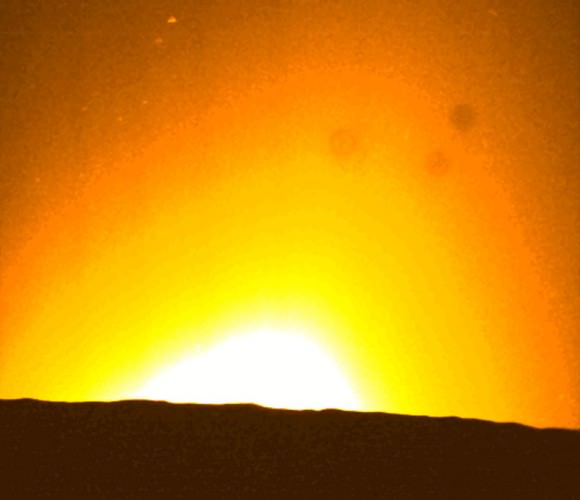
So what did LADEE see? As you watch the animation above, comprised of images taken from darkness until sunrise, you’ll see a yellow haze on the horizon that expands into large diffuse glow tilted slightly to the right. This is the zodiacal light along with a smaller measure of light coming from sun’s outer atmosphere or corona. Together they’re referred to as CZL or ‘coronal and zodiacal light’. At the very end, the sun peaks over the lunar horizon.
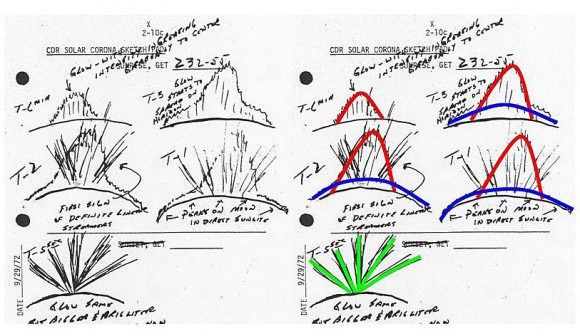
What appears to be missing from the pictures are the mysterious rays seen by some of the Apollo astronauts. The rays, neatly sketched by astronaut Eugene Cernan of Apollo 17, look a lot like those beams of light and shadow streaming though holes in clouds called crepuscular rays.
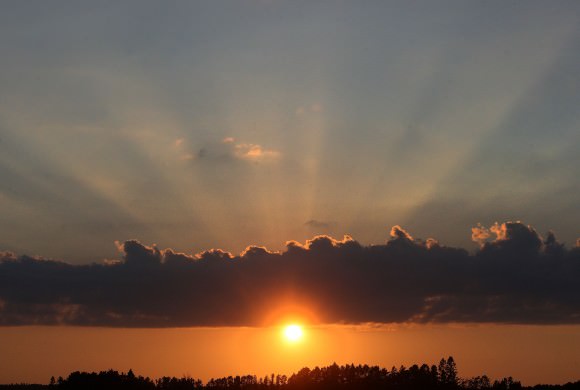
Only thing is, Earth’s atmosphere is thick enough for cloud beams. The dust in the moon’s atmosphere appears much too thin to cause the same phenomenon. And yet the astronauts saw rays as if sunlight streamed between mountain peaks and scattered off the dust just like home.
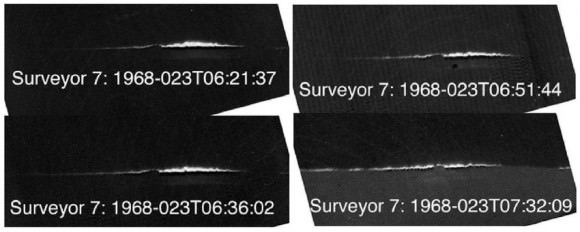
It’s believed that dust gets lofted into the spare lunar atmosphere via electricity. Ultraviolet light from the sun knocks electrons from atoms in moon dust, giving them a positive charge. Since like charges repel, bits of dust push away from one another and move in the direction of least resistance: up. The smaller the dust particle, the higher it rises until dropping back down to the surface. Perhaps these “fountains” of lunar dust illuminated by the sun are what the astronauts recorded.
Unlike Cernan, LADEE saw only the expected coronal and zodiacal light but no rays. Scientists plan to look more closely at several sequences of images made of lunar sunrise in hopes of finding them.
Book review by David Freiberg: Universe Today Book Reviewer
Most of us get up in the morning, shower, eat breakfast and sleepily make our way to work. Whether we work in an office, outdoors, with the public or in any number of exciting Earth-based careers, our daily commute can hardly compare to that of a moon astronaut! In Earthrise: My Adventures As An Apollo 14 Astronaut, Edgar Mitchell shares his personal story of how he came to share a career with a scarce 11 other people in history.
This new book tells the story Mitchell’s life; he started out as a farm boy from a small town in New Mexico who grew up in a normal family and lived a normal life but he worked hard enough and got lucky enough to go to the Moon. He wasn’t born into it, and he wasn’t so supremely gifted that he aced everything he tried in his life. He had the willpower to work through years of training, and he had the courage to get into a gigantic rocket that would launch him a quarter of a million miles through space, even though the last people who had tried to go to the Moon were lucky to get back alive.
And, being a real person doing an extraordinary thing, he came back changed by the experience.
Despite the trials and tribulations of training, of flying there, of a close call with a malfunctioning “abort” button, and of the moonwalk itself, Edgar details how the ride home was the most life-changing part of the entire journey. As he saw the Earth shining in front of him, he described a sensation he called metanoia that was to shape the rest of his life. He’d explored as much of outer space as current technology would allow: now he wanted to do the opposite and explore the mind. Though he’d always been interested in topics like ESP (he even conducted his own ESP experiment with a few doctors on Earth during the mission), it was easy to see how it changed his perspective on everything. And, from his descriptions, he’s not the only Apollo astronaut to have a different perspective on life after the mission: they were real people, after all, and if you went to the Moon, you’d probably be changed as well.
That’s where “Earthrise” really shines: you get the idea that you too could do the same thing if you were willing to work for it. This book is strongly recommended for all children who are interested in space; as Edgar Mitchell was inspired by stories of Roswell and of Buck Rogers when he was young, perhaps a child who reads this very book will someday fly around the Moon and watch the Earth come up.
About the authors: Dr. Edgar Mitchell was a pilot in the historic 1971 Apollo 14 mission and the sixth man to ever walk on the Moon. He is the author of “Paradigm Shift,” “The Space Less Traveled,” and “The Way of the Explorer,” and recipient of the Presidential Medal of Freedom, the NASA Distinguished Service Medal, three NASA Group Achievement Awards and was nominated for the Nobel Peace Prize in 2005. He is the founder of the renowned Institute of Noetic Sciences and lives in Lake Worth, Florida. Ellen Mahoney has worked for Walt Disney Imagineering and produced radio features for the BBC Science in Action show. She is an instructor of journalism at Metro State University of Denver and lives in Boulder, Colorado. Dr. Brian Cox is a professor of particle physics at the University of Manchester School of Physics and Astronomy, Manchester, England. He presents space and science programs on BBC radio and television, including “Wonders of the Universe.”
Universe Today and Chicago Review Press are pleased to be able to offer three free copies of “Earthrise: My Adventures as An Apollo 14 Astronaut” to our readers. This contest is open to US and Canadian residents only. In order to be entered into the giveaway drawing, just put your email address into the box at the bottom of this post (where it says “Enter the Giveaway”) before Wednesday, April 30, 2014. If this is the first time you’re registering for a giveaway, you’ll receive a confirmation email immediately where you’ll need to click a link to be entered into the drawing. For those who have registered previously, you’ll receive an email later where you can enter this drawing.
If you are not lucky enough to win one of our three free copies, or if you don’t want to wait, you can purchase the book from Amazon.com.
The space community lost a colossus of the of the Apollo era last week, when John Houbolt passed away last Tuesday just five days after his 95th birthday.
Perhaps the name isn’t as familiar to many as Armstrong or Von Braun, but John Houbolt was a pivotal figure in getting us to the Moon.
Born in Altoona, Iowa on April 10th, 1919, Houbolt spent most of his youth in Joliet, Illinois. He earned a Masters degree in Civil Engineering from the University of Illinois at Urbana-Champaign in 1942 and a PhD in Technical Sciences from ETH Zurich in Switzerland in 1957. But before that, he would become a member of the National Advisory Committee for Aeronautics (NACA) in 1942, an organization that would later become the National Aeronautics and Space Administration or NASA in 1958.
It was 1961 when Houbolt made what would be his most enduring mark on the space program. He was working as an engineer at the Langley Research Center, at a time when NASA and the United States seriously needed a win in the space race. The U.S.S.R. had enjoyed a long string of firsts, including first satellite in orbit (Sputnik 1, October 1957), first spacecraft to photograph the lunar farside (Luna 3 in October 1959) and first human in space with the launch of Yuri Gagarin aboard Vostok 1 in April 1961. A young President Kennedy would make his now famous “We choose to go to the Moon…” speech at Rice University later the next year in late 1962. Keep in mind, in U.S. astronaut John Glenn had just made his first orbital flight months before Kennedy’s speech, and total accumulated human time in space could be measured in mere hours. Unmanned Ranger spacecraft were having a tough time even getting off of the pad, and managing to crash a space probe into the Moon was considered to be a “success”. The task of sending humans “by the end of this decade” was a daunting one indeed…
NASA would soon have a mandate to sent humans to the Moon: but how could they pull it off?
Early ideas for manned lunar missions envisioned a single gigantic rocket that would head to the Moon and land, Buck Rodgers style, “fins first.” Such a rocket would have to be enormous, and carry the fuel to escape Earth’s gravity well, land and launch from the Moon, and return to Earth.
A second approach, known as Earth-orbit rendezvous, would see several launches assemble a mission in low Earth orbit and then head to the Moon. Curiously, though this was an early idea, it was never used in Apollo, though it was briefly resurrected during the now defunct Constellation Program.
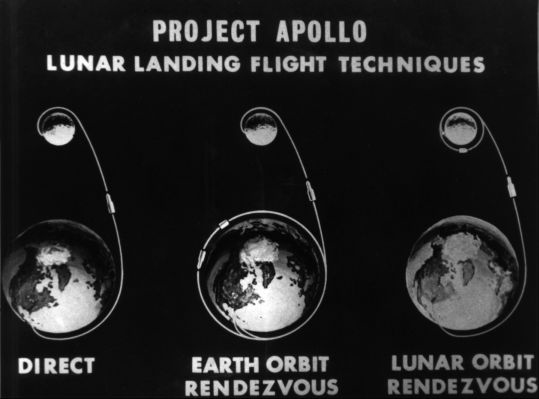
But it was a third option that intrigued Houbolt, known as Lunar Orbit Rendezvous. LOR had been proposed by rocket pioneers Yuri Kondratyuk and Hermann Oberth in 1923, but had never been seriously considered. It called for astronauts to depart the Earth in a large rocket, and instead, use a small lander designed only to land and launch from the Moon while the spacecraft for Earth return orbited overhead.
Houbolt became a staunch advocate for the idea, and spent over a year convincing NASA officials. In one famous letter to NASA associate administrator Robert Seamans, Houbolt was known to have remarked “Do we want to go to the Moon or not?”
It’s interesting to note that it was probably only in a young organization like the NASA of the early 1960s that, in Houbolt’s own words, a “voice in in the wilderness” could be heard. Had NASA become a military run organization — as many advocated for in the 1950s — a rigid chain of command could have meant that such brash ideas as Houbolt’s would have never seen the light of day. Thank scientists such as James Van Allen for promoting the idea of a civilian space program that we take for granted today.
Even then, selling LOR wasn’t easy. The idea looked preposterous: astronauts would have to learn how to undock and dock while orbiting a distant world, with no chance of rescue. There was no second chance, no backup option. Early plans called for an EVA for astronauts to enter the Lunar Module prior to descent which were later scrapped in favor of extracting it from atop the third stage and boarding internally before reaching the Moon.
Once Houbolt had sold key visionaries such as Wernher von Braun on the idea in late 1962, LOR became the way we would go to the Moon. And although Houbolt’s estimations of the mass required for the Lunar Module were off by a factor of three, the story is now the stuff of early Apollo era legend. You can see Houbolt (played by Reed Birney) and the tale of the LM and LOR in the From Earth to the Moon episode 5 entitled “Spider”.

Houbolt was awarded NASA’s medal for Exceptional Scientific Achievement in 1963, and he was in Mission Control When Apollo 11 touched down in the Sea of Tranquility.
He passed away in a Scarborough, Maine nursing home last Tuesday, and joins other unsung visionaries of the early space program such as Mary Sherman Morgan. It’s sad to think that we may soon live in a world where those who not only walked on the Moon, but those who also sent us and knew how to get there, are no longer with us.
Thanks, John… you gave us the Moon.